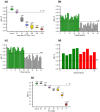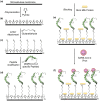Development and Analytical Evaluation of a Point-of-Care Electrochemical Biosensor for Rapid and Accurate SARS-CoV-2 Detection
- PMID: 37766054
- PMCID: PMC10534802
- DOI: 10.3390/s23188000
Development and Analytical Evaluation of a Point-of-Care Electrochemical Biosensor for Rapid and Accurate SARS-CoV-2 Detection
Abstract
The COVID-19 pandemic has underscored the critical need for rapid and accurate screening and diagnostic methods for potential respiratory viruses. Existing COVID-19 diagnostic approaches face limitations either in terms of turnaround time or accuracy. In this study, we present an electrochemical biosensor that offers nearly instantaneous and precise SARS-CoV-2 detection, suitable for point-of-care and environmental monitoring applications. The biosensor employs a stapled hACE-2 N-terminal alpha helix peptide to functionalize an in situ grown polypyrrole conductive polymer on a nitrocellulose membrane backbone through a chemical process. We assessed the biosensor's analytical performance using heat-inactivated omicron and delta variants of the SARS-CoV-2 virus in artificial saliva (AS) and nasal swab (NS) samples diluted in a strong ionic solution, as well as clinical specimens with known Ct values. Virus identification was achieved through electrochemical impedance spectroscopy (EIS) and frequency analyses. The assay demonstrated a limit of detection (LoD) of 40 TCID50/mL, with 95% sensitivity and 100% specificity. Notably, the biosensor exhibited no cross-reactivity when tested against the influenza virus. The entire testing process using the biosensor takes less than a minute. In summary, our biosensor exhibits promising potential in the battle against pandemic respiratory viruses, offering a platform for the development of rapid, compact, portable, and point-of-care devices capable of multiplexing various viruses. The biosensor has the capacity to significantly bolster our readiness and response to future viral outbreaks.
Keywords: SARS-CoV-2; electrochemical biosensor; impedance spectroscopy; lactam-stapled peptide.
Conflict of interest statement
The authors declare no conflict of interest.
Figures




Similar articles
-
Sustainable Electrochemical-Magnetic Biosensor Fabricated from Recycled Materials for Label-Free Detection of SARS-CoV-2 in Human Saliva.ACS Sens. 2025 Mar 28;10(3):1970-1985. doi: 10.1021/acssensors.4c03175. Epub 2025 Mar 14. ACS Sens. 2025. PMID: 40084631 Free PMC article.
-
Nanostructured sensor platform based on organic polymer conjugated to metallic nanoparticle for the impedimetric detection of SARS-CoV-2 at various stages of viral infection.J Pharm Biomed Anal. 2021 Nov 30;206:114392. doi: 10.1016/j.jpba.2021.114392. Epub 2021 Sep 24. J Pharm Biomed Anal. 2021. PMID: 34607201 Free PMC article.
-
Sensitive Detection of SARS-CoV-2 Variants Using an Electrochemical Impedance Spectroscopy Based Aptasensor.Int J Mol Sci. 2022 Oct 28;23(21):13138. doi: 10.3390/ijms232113138. Int J Mol Sci. 2022. PMID: 36361926 Free PMC article.
-
Electrochemical Biosensors for the Detection of SARS-CoV-2 and Other Viruses.Micromachines (Basel). 2021 Feb 10;12(2):174. doi: 10.3390/mi12020174. Micromachines (Basel). 2021. PMID: 33578979 Free PMC article. Review.
-
Biosensors for the detection of respiratory viruses: A review.Talanta Open. 2020 Dec;2:100007. doi: 10.1016/j.talo.2020.100007. Epub 2020 Aug 16. Talanta Open. 2020. PMID: 34913046 Free PMC article. Review.
References
-
- Mohite V., Vyas K., Phadke G., Rawtani D. COVID-19 in the Environment. Elsevier; Amsterdam, The Netherlands: 2022. Challenges and Future Aspects of COVID-19 Monitoring and Detection; pp. 131–150.
LinkOut - more resources
Full Text Sources
Research Materials
Miscellaneous

